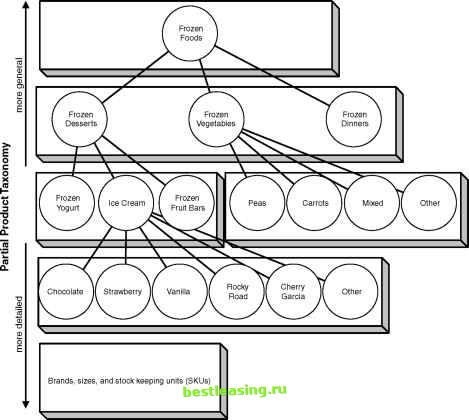

 |
 |

|
Промышленный лизинг
Методички
 First determine the right set of items and the right level. For instance, is pizza an item or are the toppings items?
 Л в o°8o Next, calculate the probabilities and joint probabilities of items and combinations of interest, perhaps limiting the search using threshholds on support or value. Finally, analyze the probabilities to determine the right rules. If mushroom then pepperoni. Q>-> © Figure 9.9 Finding association rules has these basic steps. Choosing the Right Set of Items The data used for finding association rules is typically the detailed transaction data captured at the point of sale. Gathering and using this data is a critical part of applying market basket analysis, depending crucially on the items chosen for analysis. What constitutes a particular item depends on the business need. Within a grocery store where there are tens of thousands of products on the shelves, a frozen pizza might be considered an item for analysis purposes-regardless of its toppings (extra cheese, pepperoni, or mushrooms), its crust (extra thick, whole wheat, or white), or its size. So, the purchase of a large whole wheat vegetarian pizza contains the same frozen pizza item as the purchase of a single-serving, pepperoni with extra cheese. A sample of such transactions at this summarized level might look like Table 9.3. Table 9.3 Transactions with More Summarized Items
On the other hand, the manager of frozen foods or a chain of pizza restaurants may be very interested in the particular combinations of toppings that are ordered. He or she might decompose a pizza order into constituent parts, as shown in Table 9.4. At some later point in time, the grocery store may become interested in having more detail in its transactions, so the single frozen pizza item would no longer be sufficient. Or, the pizza restaurants might broaden their menu choices and become less interested in all the different toppings. The items of interest may change over time. This can pose a problem when trying to use historical data if different levels of detail have been removed. Choosing the right level of detail is a critical consideration for the analysis. If the transaction data in the grocery store keeps track of every type, brand, and size of frozen pizza-which probably account for several dozen products-then all these items need to map up to the frozen pizza item for analysis. Table 9.4 Transactions with More Detailed Items
Product Hierarchies Help to Generalize Items In the real world, items have product codes and stock-keeping unit codes (SKUs) that fall into hierarchical categories (see Figure 9.10), called a product hierarchy or taxonomy. What level of the product hierarchy is the right one to use? This brings up issues such as Are large fries and small fries the same product? Is the brand of ice cream more relevant than its flavor? Which is more important: the size, style, pattern, or designer of clothing? Is the energy-saving option on a large appliance indicative of customer behavior?  Figure 9.10 Product hierarchies start with the most general and move to increasing detail. 1 2 3 4 5 6 7 8 9 10 11 12 13 14 15 16 17 18 19 20 21 22 23 24 25 26 27 28 29 30 31 32 33 34 35 36 37 38 39 40 41 42 43 44 45 46 47 48 49 50 51 52 53 54 55 56 57 58 59 60 61 62 63 64 65 66 67 68 69 70 71 72 73 74 75 76 77 78 79 80 81 82 83 84 85 86 87 88 89 90 91 92 93 94 95 96 97 98 99 100 101 102 103 104 105 106 107 108 [ 109 ] 110 111 112 113 114 115 116 117 118 119 120 121 122 123 124 125 126 127 128 129 130 131 132 133 134 135 136 137 138 139 140 141 142 143 144 145 146 147 148 149 150 151 152 153 154 155 156 157 158 159 160 161 162 163 164 165 166 167 168 169 170 171 172 173 174 175 176 177 178 179 180 181 182 183 184 185 186 187 188 189 190 191 192 193 194 195 196 197 198 199 200 201 202 203 204 205 206 207 208 209 210 211 212 213 214 215 216 217 218 219 220 221 222 |